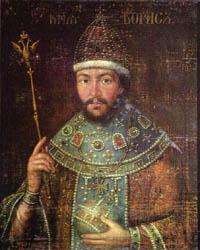You can help expand this article with text translated from the corresponding article in Russian. (April 2024) Click [show] for important translation instructions.
|
This article needs additional citations for verification. (November 2023) |
| Russo-Swedish War (1590–1595) | |||||||||
|---|---|---|---|---|---|---|---|---|---|
| Part of the Russo-Swedish wars | |||||||||
 Boris Godunov | |||||||||
| |||||||||
| Belligerents | |||||||||
|
|
| ||||||||
| Commanders and leaders | |||||||||
|
|
| ||||||||
| Strength | |||||||||
| Unknown | 25,000 | ||||||||
| Casualties and losses | |||||||||
| Unknown | Unknown | ||||||||
The Russo-Swedish War of 1590–1595 was instigated by Boris Godunov in the hope of gaining the territory of the Duchy of Estonia along the Gulf of Finland belonging to Sweden since the previous Livonian War. As soon as the Truce of Plussa expired early in 1590, a large Russian army led by Godunov and his sickly brother-in-law, Feodor I of Russia, marched from Moscow towards Novgorod. On 18 January they crossed the river Narva and laid siege to the Swedish castle of Narva, commanded by Arvid Stålarm. Another important fortress, Jama (Jamburg), fell to Russian forces within two weeks. Simultaneously, the Russians ravaged Estonia as far as Reval (Tallinn) and Finland as far as Helsingfors (Helsinki).
On 25 February, the local Swedish governor, Carl Henriksson Horn af Kanckas, was compelled to sign an armistice, which obliged Sweden to surrender the territories won by the Treaty of Plussa — namely Jama, Koporye, and Ivangorod. This peace settlement displeased John III of Sweden, who sent a fleet to take hold of Ivangorod, but this attempt to besiege the fortress was checked by a Russian castellan. Matters then remained quiet until summer 1591, when the Swedes struck against Gdov, capturing a local governor, Prince Vladimir Dolgorukov.
The other war theatre was East Karelia, where the Swedes sacked Kola and other Russian settlements bordering the White Sea. A raiding party allegedly led by Finnish peasant chief Pekka Vesainen, destroyed the Pechenga Monastery on 25 December 1589, killing 50 monks and 65 lay brothers. He then turned his troops to Kola Fjord but could not manage to destroy the Kola Fortress due to lack of men. Instead he captured and burned Kandalaksha (Kantalahti) and a small Russian settlement in Kem. Again, due to lack of men, he could not capture the Solovetsky Monastery on the Solovetsky Islands.
Godunov's government gradually overcame those setbacks, as Prince Volkonsky was sent to pacify Karelia, and the noblest Russian generals Bogdan Belsky, Fedor Mstislavsky, and Prince Trubetskoy devastated Finland. Then, the war settled into indecisive skirmishing from which it would not subsequently emerge. Three years elapsed before Sweden, in May 1595, agreed to sign the Treaty of Teusina (Tyavzino, Tyavzin, Täyssinä). It restored to Russia all territory ceded in the Treaty of Plussa of 1583 to Sweden except for Narva. Russia had to renounce all claims on Estonia, including Narva, and Sweden's sovereignty over Estonia from 1561 was confirmed.[7]
References edit
- ^ Sundberg, Ulf (2002). Svenska krig 1521-1814 (in Swedish) (2nd ed.). Stockholm: Hjalmarson & Högberg. p. 75. ISBN 9789189080140.
Lugnet lägrar sig och kvarstår fram till den 18 maj 1595, då Freden i Teusina sluts. Freden kan betecknas som bra för Sverige.
- ^ KISER, EDGAR, et al. “THE RELATIONSHIP BETWEEN REVOLT AND WAR IN EARLY MODERN WESTERN EUROPE.” Journal of Political & Military Sociology, vol. 22, no. 2, 1994, pp. 305–24. JSTOR, http://www.jstor.org/stable/45371312 Archived 8 April 2023 at the Wayback Machine. Accessed 6 December 2023.
- ^ Roberts, Michael (10 July 2014). Gustavas Adolphus. Routledge. ISBN 978-1-317-89576-3. Archived from the original on 7 January 2024. Retrieved 26 December 2023.
- ^ "Archived copy". Archived from the original on 6 December 2022. Retrieved 6 January 2024.
{{cite web}}: CS1 maint: archived copy as title (link) - ^ https://web.archive.org/web/20071029024931/http://www.smb.nu/svenskakrig/1570.asp
- ^ "Relations With Sweden | Encyclopedia.com". www.encyclopedia.com. Archived from the original on 18 December 2023. Retrieved 18 December 2023.
- ^ a b c d e Black, Jeremy (28 March 1996). The Cambridge Illustrated Atlas of Warfare: Renaissance to Revolution, 1492-1792. Cambridge University Press. ISBN 978-0-521-47033-9. Archived from the original on 7 December 2023. Retrieved 2 December 2023.